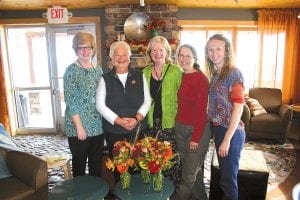The Cook County Collective. The Center for Family Crisis. The Violence Prevention Center. …A rose by any other name would smell as sweet…Shakespeare said it well, and no matter what this community service has been called in its 25-year history, it has been an oasis for many community members caught in difficult life circumstances.
“Names change, logos change. What hasn’t changed is the mission: safety for women and children, men and families,” said Violence Prevention Center Director Jodi Yuhasey at an October 12, 2011 Brown Bag Lunch at East Bay celebrating the Center’s presence in the community.
It’s important to not forget what it was like before services were available, Yuhasey said, before law enforcement, health care, and the court system were educated, supportive, and equipped to help community members struggling with domestic and sexual violence and abuse.
Three of the program’s pioneers shared some of their experiences getting the program launched. “We were so concentrated on doing and making things that I don’t think we took note of where we came from,” said Melinda Spinler. The services started out of Cook County Public Health & Human Services, but legislative changes required that the program be picked up by the community. Lucy Dols, whose husband was Grand Marais police officer Jim Dols, was its first paid employee.
Kay Costello recalled the colorful T-shirts they made to advertise the program. “It was really important to us to establish a visual of what we were doing, who we represented, and who we were trying to reach,” she said.
Costello commended Yuhasey and her colleague at the Violence Prevention Center, Program Advocate Kayla O’Bryan, for their work. “Doing this kind of work in a fishbowl like this is really hard,” she said. She talked with respect for the people who have sought help from the program. “These are really deep issues that hurt people deeply,” she said. “It’s an honor to connect with people on them.”
Christie Buetow remembers writing grants and working with state agencies when the program started, and she appreciated all those who helped. “There was always this trained base of advocates who were ready to respond to whatever the needs were,” she said. Buetow has been a social worker at North Shore Hospital and Care Center for many years. She said she has seen older women who have lived their entire lives in emotionally or physically abusive relationships in which the abuse ended only when they entered the Care Center.
Have attitudes toward the program’s presence shifted over time? Yes, said Melinda Spinler. People didn’t see abuse even though it was happening, she said. “It was total rose-colored glasses.” Law enforcement was not trained in this issue and didn’t know how to respond to it. In fact, Spinler said, the sheriff ’s attitude toward solving a domestic problem was “a big 2×4 upside the head.”
The county attorney’s office used to ask the advocates how they should handle domestic violence cases, Spinler said. They found power in numbers, though, she said, and they started sending several advocates to court with each victim’s main advocate.
Buetow said at the beginning, very few cases made it to court. Victims blamed themselves and believed they could have done something to avoid the abuse. The advocates spent a lot of time showing people “there’s a better way to live,” she said.
Eventually, Spinler said, the community started understanding that taking a case to court was “not just airing your dirty laundry in public” – it was a community problem.
These days, pressing charges is not up to the victim, Yuhasey said, and that is significant progress.
While attitudes and skills have improved over the years, the nation’s economic situation has made continued funding for domestic and sexual abuse and violence programs precarious. Spinler expressed a concern that in some places, money has been spent prosecuting drug possession charges while domestic violence programs have lost funding.
One thing the program has helped change is acceptance of older men soliciting young girls. A story was told regarding men in their 30s waiting inside the halls of Cook County High School for their girlfriends to get out of school. A former pastor received death threats, one person said, after writing a letter to the editor decrying such behavior. The school sought the help of the Violence Prevention Center, which helped educate people about how detrimental these relationships were.
Another move forward is that abused men are asking for services as well.
The group discussed their opinions of what has or has not improved over the years. “We have to work for it,” one person said, “whether we’re optimistic or pessimistic.”
“The program wouldn’t be here for 25 years without the support of the community,” said Yuhasey. She thanked the three early advocates, saying, “You made the world a better place.” To everyone she said, “Be safe. Be respectful, and keep sharing your stories. They make a difference.”
Starting October 27,therapist Linda Vanden Brook, MA, LMFT, will be leading a fourweek group at the Violence Prevention Center for survivors of emotional abuse. For more information, call the Center at (218)387-1262 or Vanden Brook at (218)370-1600.



Leave a Reply